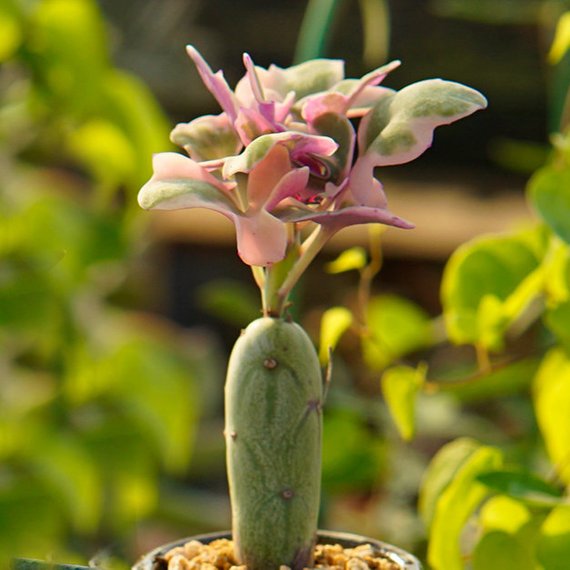Senecio articulatus 'Candlelight' can maintain a perennial verdant color, with plants typically growing to heights of 30 to 60 centimeters. Its branches are chubby-looking, with sections one after another. The backs of the leaves are generally dark green, while variegated varieties have purple leaves.
During the high-temperature seasons of summer and autumn, the Senecio articulatus 'Candlelight' generally enters a dormant state and does not grow much. In the winter and spring seasons when the weather is cooler, it tends to grow more. If it receives sufficient light in its care location, it can also produce small white flowers, resembling wild daisies.
Soil:
Planting Senecio articulatus 'Candlelight' does not require very picky soil. Succulent-specific soil mixed with some granular soil can be used. For example, mix peat soil and granular soil in a 1:1 ratio. Common granular soil options include red loam, deer loam, perlite, and volcanic rock. Select two or three to mix.
Alternatively, coarse sand and garden soil can be mixed in a 2:1 ratio. Coarse sand and peat soil can also be mixed in a 1:1 ratio. The soil acidity should not be too strong.
Temperature:
The Senecio articulatus 'Candlelight' is particularly suitable as an indoor potted plant, with poor cold resistance. The minimum maintenance temperature in winter should be kept above 7 degrees Celsius, with the optimal growth temperature between 15 to 25 degrees Celsius. During periods of high summer temperatures, shading should be applied, and it is perfectly fine to keep it in semi-shaded areas.
Light:
The Senecio articulatus 'Candlelight' does not have particularly strong light requirements. It can meet its growth needs with 3 to 5 hours of scattered light per day. During the cool weather of winter and spring, it can be exposed to more sunlight, while during high-temperature seasons, it is best to move it to a ventilated and shaded location.
Watering:
The Senecio articulatus 'Candlelight' does not have a strong demand for water, and many people fail to care for it properly by watering too frequently. It's important to wait until the soil is completely dry before considering watering (indoors, watering thoroughly once a month is sufficient). During hot summer and autumn seasons, especially when temperatures exceed 30 degrees Celsius, water control should be observed. When temperatures are excessively high, even watering should be stopped because it will be in a dormant state and unable to absorb water.
Propagation:
To propagate the Senecio articulatus 'Candlelight', stem cuttings can be used in spring and autumn. Once the stem nodes are relatively long, cut them into sections about 7 to 9 centimeters long. Place them in a ventilated area to dry the wounds, then insert them into loose, well-draining sandy soil (clean and breathable soil).
Many people struggle with potted plants, and most failures with the Senecio articulatus 'Candlelight' are due to excessive watering, leading to root rot from overly moist soil. When planting indoors, attention should also be paid to preventing red spider mites and scale insects.
